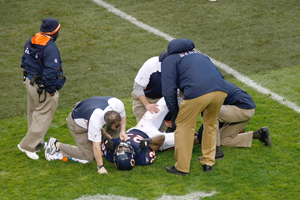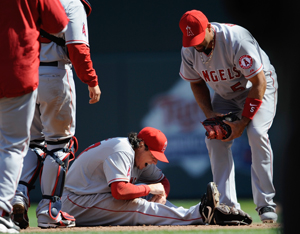When Ryan Howard goes to the ground with a snapped Achilles or Adrian Peterson gets carted off with a knee injury, what happens next? Behind the scenes, there’s a lot going on besides a trip to the surgeon or rehab specialist.
Injuries are the fourth-largest cost to sports franchises, after payroll, facilities and marketing. In MLB, teams have lost over half a billion dollars to injuries in only the last five years, based on industry research provided to SportsBusiness Journal. That estimate is based on salary payments that still must go to players who are on the disabled list and unable to play. For a team that has lost a star, it goes beyond the lost payroll and lost time to potentially affecting the gate and marketing plans.
By the time a player is helped off the field, the process to get him back to competition has already begun. A network of athletic trainers, physicians, insurance specialists and rehab professionals will spend the next weeks or months working to make sure that the athlete returns at the same level and that the costs are contained for the team.
First responders
The first contact point for any injury is the athletic trainer. The head athletic trainer not only is likely to have been the first responder, but is going to manage the process in most organizations.
 |
Athletic trainers are the first responders when a player is injured, and later manage any rehabilitation process that may be required.
Photo by: Getty Images |
Some baseball teams use a “medical director” model, similar to systems used in European soccer. It allows more man-hours to be focused on treatment and prevention by the head athletic trainer and his staff, rather than dealing with paperwork, insurance and travel. The medical director gets an electronic report generated by the trainers, which begins the process.
At the point of injury, the first physician the player is likely to see is the team’s own staff physician. Some NFL teams take their physicians on road trips, but the more common model is to use the home team’s physician as a “first touch.”
Each team has a network of physicians in every specialty available, at both the major and minor league level. In some cases, care is linked back to clinics that have official provider status as team sponsors. Examples of those sponsorships include the deal between the New York Jets and Atlantic Health System, the Oklahoma City Thunder and Integris Health, and the New York Mets with the Hospital for Special Surgery.
 |
Players check on Los Angeles Angels pitcher Scott Downs after he was injured in a game on April 12.
Photo by: Getty Images |
The team physician will almost always see the injured athlete and advise the club, so if the injury occurs on the road, he’s usually the second doctor to see the athlete.
Some teams believe that continuity of care is the key factor and will get their player to their team doctor as fast as possible following a road game injury. For players assigned to minor league clubs, the decision is made quickly as to whether the injured athlete will stay with the local doctors or if the injury is serious enough to get him in with the parent club and its physicians.
At this point, teams can begin to decide whether the player is likely to be sidelined for shorter periods or if the injury is more extensive. That in turn triggers clauses in each league’s labor agreement on the process for roster moves and any hiring of replacement players that might be needed.
If the injury is going to require significant rehab time or surgery, the player’s agent usually gets involved.
| Turnkey Sports Poll |
| The following are results of the Turnkey Sports Poll taken in March. The survey covered more than 1,100 senior-level sports industry executives spanning professional and college sports. |
|
|
| Do professional sports leagues have the obligation to continue to support and provide care for athletes after their retirement? |
| Yes |
71% |
| No |
25% |
| Not sure / No response |
4% |
| In the next 12 months, do you expect the rate of player concussions in the NFL and NHL to go up, go down, or remain flat? |
| Up |
39% |
| Flat |
40% |
| Down |
20% |
| Not sure / No response |
1% |
| Source:Turnkey Sports & Entertainment in conjunction with SportsBusiness Journal. Turnkey Intelligence specializes in research, measurement and lead generation for brands and properties. Visit www.turnkeyse.com. |
“The agent is the key to the whole process,” said Kendra Dalby, a lead assistant to Dr. Tim Kremchek at Beacon Orthopaedics in Cincinnati, the lead medical provider for the Cincinnati Reds and other area teams. “They know the athlete. They know the family. They know the team. In some cases, they know the doctor. It’s why you see some agents’ clients always going to one doctor or another. It’s the trust, the familiarity.”
So for the athlete, it’s a decision of whether to be treated by the team’s medical staff or to go with an outside physician. Like consumers in general, the final choice of doctor is just that — a choice.
The second opinion is now almost standard in all injuries, especially in cases that may require surgery.
An MLB-certified agent, who declined to be named for this article, said he gets involved early in the process. He echoed a sentiment often voiced by other agents.
“If there’s even a chance of surgery, I’m putting in the request [for a second opinion]. I’m not letting him get cut on by anyone but one of the best.”
Dr. Lewis Yocum, team physician for the Los Angeles Angels of Anaheim and one of the top surgeons in baseball, said he deals most often with the player directly, but is used to having agents as part of the process.
“As the appointments are usually scheduled and paid for by the team, their team physician and trainer will be notified,” Yocum said. “Many times an agent will accompany the player to the exam.”
Like any doctor-patient relationship, one of the keys is that initial trust, Yocum said, no matter how many people are in orbit around the process.
Doctors, cost structures
Many doctors and clinics have carved niches for themselves by specializing in treatment of specific sports injuries. In addition to Yocum, names such as James Andrews, Steve O’Brien, Neal ElAttrache and Kremchek have become recognizable to even the casual sports fan.
Imaging, consultations and even the surgery are all done based on a “usual and customary” chart of charges put together by medical insurance carriers or the workers’ compensation programs from various states.
Teams typically don’t carry medical insurance on players. The costs incurred for surgery and rehab are first filed as a
workers’ compensation claim. The team then picks up any charges that aren’t covered by workers’ comp.
“We have negotiated rates with all our providers and hospitals,” said Roger Caplinger, the director of medical operations for the Milwaukee Brewers. “It can be a huge cost savings.”
Teams have negotiated rates with some of the super-surgeons, so even if a player chooses to go outside a team’s regular network, it’s rare for the player to incur any of the cost of treatment.
Timing is key as well. A player who is injured in the offseason and rehabs at home can invoke huge costs, since he is away from the team’s medical staff and has to rely on a third party.
“They rehab three times a week, and if it’s something like a Tommy John [surgery], it can go on for months,” Caplinger said.
Teams conduct routine checks with players during the rehabilitation process. How soon, and whether, a player returns depends not so much on the player’s willingness to play or the sign-off from doctors, but how well the healing has progressed and whether the player can perform at the required level.
One of the biggest focal points of sports medicine today is the treatment and management of concussions, which offer challenges in the short- and long-term that are more difficult than any sprain or strain.
Lawsuits in play, including those filed by former players against the NFL, have forced leagues to re-evaluate their approach to concussion prevention, diagnosis and treatment.
| MLB disabled list trends |
| Year |
DL stints |
Days lost |
| 2011 |
515 |
25,285 |
| 2010 |
459 |
23,579 |
| 2009 |
478 |
26,173 |
| 2008 |
532 |
28,459 |
| Source: MLB |
MLB has instituted a concussion protocol at the recommendation of a committee established three years ago. The biggest change is a seven-day “concussion disabled list” that gives each team’s medical staff longer to evaluate players.
The NFL’s concussion protocol has been in place for several years, but was revamped prior to the start of the 2011-12 season, requiring baseline tests and a sign-off from a neurologist. The NFL also, late this past season, added an observer to watch for concussions from the booth, a move prompted by the handling of a head injury to Cleveland Browns quarterback Colt McCoy.
The NFLPA has a pilot program where sensors are installed in a player’s helmet to register the forces of hits. The technology was used during the Super Bowl and will continue in the preseason.
The NHL has largely followed the NFL’s policy until this year. The league has instituted a behind-the-scenes concussion tracking program to monitor for any spikes in such injuries.
The cost of injuries goes beyond medical bills, workers’ comp, and even the salary lost. Wins vanish. Dreams fade. Careers are ended. Teams pay in ways that go far from the bottom line, which emphasizes the need to try to minimize the number of injuries.
“Continued support of research and education for the prevention of sports injuries are dollars well spent today that will yield a high return on investment for athletes at all levels of play,” said Dr. Ralph Gambardella, head of the Kerlan-Jobe Orthopaedic Clinic in Los Angeles.
“The old saying still rings true: An ounce of prevention is worth a pound of cure.”
Will Carroll, a writer in Indianapolis, specializes in covering sports injuries.





